|
THE SATHYA SAI STORY
November 23,
1926, is a red-lettered day in the history of mankind. On
that day was born in the (then) obscure village of Puttaparthi,
a charming young baby boy in the Ratnakara family. None realised
then, and indeed for a long time thereafter, that Divinity
had incarnated in human form as Ratnakara Venkata Satyanarayana
Raju, grandson of Kondama Raju, and son of Pedda Venkama Raju
and Easwaramma.
 The
birth of ordinary mortals is the direct consequence of earlier
lives. The Karma or the track-record of earlier births,
i.e., the nature of deeds performed, both good and bad, determine
the future Janmas or births. In short, human birth is a Karma
Janma (birth that is the consequence of earlier births).
However, when the Lord comes down in human form, it is a different
story altogether. He incarnates as a part of His unfathomable
Cosmic Drama, to play as it were, a cameo role. He decides
the time and the place of His incarnation, the parents, and
also how His life would unfold. Thus the Lord's birth as a
human is a part of His Divine Sport or Leela; in other
words, His life is a Leela Janma. The
birth of ordinary mortals is the direct consequence of earlier
lives. The Karma or the track-record of earlier births,
i.e., the nature of deeds performed, both good and bad, determine
the future Janmas or births. In short, human birth is a Karma
Janma (birth that is the consequence of earlier births).
However, when the Lord comes down in human form, it is a different
story altogether. He incarnates as a part of His unfathomable
Cosmic Drama, to play as it were, a cameo role. He decides
the time and the place of His incarnation, the parents, and
also how His life would unfold. Thus the Lord's birth as a
human is a part of His Divine Sport or Leela; in other
words, His life is a Leela Janma.
In the Sathya Sai Incarnation, the Lord chose the Ratnakara
family on account of the purity, the piety, and the devotion
of its members. Prior to the incarnation, Pedda Venkama Raju
and Easwaramma had been blessed with one son and two daughters
- Seshama Raju, Venkamma, and Parvathamma, in that order.
Some years passed and Mother Easwaramma longed for another
son. She observed all the prescribed austerities and soon
her prayers were answered - she was to become a mother again.
Even before its birth, Easwaramma knew that the child to be
born would be unusual. There was a definite reason for such
a belief.
Sometime prior to the birth of Swami, Lakshmamma, the mother-in-law
was engaged in the worship of Lord Sathyanarayana. The Lord
then appeared in Lakshmamma's dream and blessed her, indicating
that He would be born in her family. Promptly, Lakshmamma
alerted Easwaramma that the latter might have strange experiences
but ought not to worry about them. Shortly thereafter, Easwaramma
had precisely one such experience.
One day as she was drawing water from the
well, Easwaramma was startled by the sight of a big blue ball
of light. The ball came directly towards her and entered her;
Easwaramma fainted and fell. The Lord had entered her womb
for the mandatory stay prior to physical birth as Sathyanarayana
Raju. Thus the Lord was not begotten but immaculately conceived,
even as His Son had been, two thousand years ago. 
Sathya was born in the early hours of November 23, 1926.
There were any number of unusual incidents accompanying His
birth, as also in His childhood (as in the case of Krishna).
Though they all gave strong hints of about His Divinity, few
realised until much later that Sathya was the Lord Himself.
But all unfailingly recognised that Sathya was most unusual,
extra-ordinarily intelligent, precocious, and above all, always
full of Love and compassion.
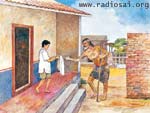 In
Primary School, Sathya helped His classmates in diverse ways.
Though Himself from a poor family, He did not hesitate to
give away His clothes to needy mates. More important, He never
lost an opportunity to turn the minds of His friends towards
God. Among other things, He formed a Bhajan group for
this purpose, which later became very popular. In
Primary School, Sathya helped His classmates in diverse ways.
Though Himself from a poor family, He did not hesitate to
give away His clothes to needy mates. More important, He never
lost an opportunity to turn the minds of His friends towards
God. Among other things, He formed a Bhajan group for
this purpose, which later became very popular.
It was time to move on to Higher Secondary
School but such a school was available only in Bukkapatnam,
several kilometers to the north of Puttaparthi. Young Sathya
now had to trudge back and forth every day, no matter what
the weather, crossing fields, walking on bunds, and wading
through water, as required. In the Bukkapatnam School also,
He was a model student, ever helpful to others. Making students
God-conscious remained His prime occupation, and to hold the
attention of His mates, He would often materialise Prasaadam,
much to their amazement. 
Sathya was an automatic choice for the class-leader (Monitor),
but this brought its share of problems. Once, His teacher
asked Sathya to slap all the boys in the class for some infringement
of discipline. Instead of slapping hard as he was expected
to, Sathya merely patted the cheeks of the errant pupils.
This greatly angered the teacher, who then directed all his
wrath on the class-leader. Sathya bore the punishment in stoic
silence; for Him, it was all a part of the Drama scripted
by Him, and this particular scene was being enacted to impart
some lessons to humanity.
On another occasion, the teacher handling
a particular class-hour (period) noticed that Sathya was not
writing 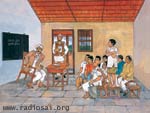 down
what was being dictated, while all other students did. When
questioned, Sathya replied that He was not taking down because
He already knew that lesson. Interpreting the response as
gross impertinence, the teacher asked Sathya to stand up on
the bench, a form of punishment popular in those days. Sathya
obediently did. After a while the School bell rang, signalling
the end of the period in progress, and the commencement of
a new period. It was time for the teacher to leave the room
and make way for another one who was to handle the next period.
Mr. Mahboob Khan, this other teacher, entered the classroom
and to his utter surprise saw Sathya standing upon the bench.
Khan loved Sathya very much, and to him it was inconceivable
that Sathya would have done anything to deserve a punishment.
He also noticed that the teacher who had handled the previous
period was not vacating the chair. To his astonishment he
then discovered that this teacher was not getting up from
the chair because he was stuck or glued to it - whenever the
teacher tried to get up, the chair also lifted! In a flash
Khan understood the problem. He asked Sathya to get down from
the bench and the stuck teacher promptly got his release!
Years later Swami disclosed that this drama was staged not
to inflict humiliation on the teacher concerned but to make
people conscious of His Divine powers. Humiliation is something
that does not exist in Swami's dictionary. down
what was being dictated, while all other students did. When
questioned, Sathya replied that He was not taking down because
He already knew that lesson. Interpreting the response as
gross impertinence, the teacher asked Sathya to stand up on
the bench, a form of punishment popular in those days. Sathya
obediently did. After a while the School bell rang, signalling
the end of the period in progress, and the commencement of
a new period. It was time for the teacher to leave the room
and make way for another one who was to handle the next period.
Mr. Mahboob Khan, this other teacher, entered the classroom
and to his utter surprise saw Sathya standing upon the bench.
Khan loved Sathya very much, and to him it was inconceivable
that Sathya would have done anything to deserve a punishment.
He also noticed that the teacher who had handled the previous
period was not vacating the chair. To his astonishment he
then discovered that this teacher was not getting up from
the chair because he was stuck or glued to it - whenever the
teacher tried to get up, the chair also lifted! In a flash
Khan understood the problem. He asked Sathya to get down from
the bench and the stuck teacher promptly got his release!
Years later Swami disclosed that this drama was staged not
to inflict humiliation on the teacher concerned but to make
people conscious of His Divine powers. Humiliation is something
that does not exist in Swami's dictionary.
Around this time, Seshama Raju went to Kamalapuram to stay
with his in-laws, and also qualify there as a teacher. Kamalapuram
boasted of a good school and Seshama Raju thought that this
was the school where Sathya ought to study - the entire family
pinned its hope on Sathya, and dreamt that one day He would
go to college and eventually end up as a big officer in the
Government. And so to Kamalpuram, Sathya went.
Seshma Raju's in-laws being relatively well-off, looked down
upon Sathya since He was quite poor. As a result, He was not
only ill-treated but also called upon to perform arduous house-hold
duties. He had, for example, to fetch drinking water everyday
from a far-off well. Such chores left scars, which remain
to this day.
In the Kamalapuram School, Sathya was a great
favourite of the Drill Master who doubled also as the Scout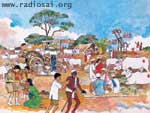 Master. Once, there was to be a grand General Fair-cum Cattle
Show in the neighbouring village of Pushpagiri. The Scout
Master wanted his troop to go Pushpagiri and render service
of the type scouts were expected to. A subscription of ten
rupees was collected from each boy for meeting the various
expenses connected with the trip, including the bus fare.
Not having the required amount, Sathya excused Himself from
joining the group but assured the Scout Master that He would
somehow or the other be in Pushpagiri at the appointed time
for duty. While His friends went by bus, Sathya walked the
entire distance, with little to eat on the way. When He finally
reached Pushpagiri, He was very tired but did not flinch from
discharging His duties. Just before returning, He thoughtfully
bought a few small gifts for folks back home. When He returned,
what greeted Him was not appreciation for the gifts but a
severe punishment because His absence had created problems
with the supply of drinking water. Much later Swami revealed
that He deliberately created such painful situations for Himself
in order to teach the lesson of forbearance and equanimity.
Despite the harsh treatment constantly administered, Swami
has never ever criticised either His elder brother or His
sister-in-law, maintaining always that they were but mere
instruments in His Drama, with specific roles to play.
Master. Once, there was to be a grand General Fair-cum Cattle
Show in the neighbouring village of Pushpagiri. The Scout
Master wanted his troop to go Pushpagiri and render service
of the type scouts were expected to. A subscription of ten
rupees was collected from each boy for meeting the various
expenses connected with the trip, including the bus fare.
Not having the required amount, Sathya excused Himself from
joining the group but assured the Scout Master that He would
somehow or the other be in Pushpagiri at the appointed time
for duty. While His friends went by bus, Sathya walked the
entire distance, with little to eat on the way. When He finally
reached Pushpagiri, He was very tired but did not flinch from
discharging His duties. Just before returning, He thoughtfully
bought a few small gifts for folks back home. When He returned,
what greeted Him was not appreciation for the gifts but a
severe punishment because His absence had created problems
with the supply of drinking water. Much later Swami revealed
that He deliberately created such painful situations for Himself
in order to teach the lesson of forbearance and equanimity.
Despite the harsh treatment constantly administered, Swami
has never ever criticised either His elder brother or His
sister-in-law, maintaining always that they were but mere
instruments in His Drama, with specific roles to play.
 His
teacher's training concluded, Seshama Raju moved from Kamalapuram
to Uravakonda to take appointment as a Telugu teacher in a
school there. Sathya went along and joined that school. Once
again He excelled in everything, and became the cynosure of
all eyes. But once He was back at home, it was the same painful
routine; no let-up at all. His
teacher's training concluded, Seshama Raju moved from Kamalapuram
to Uravakonda to take appointment as a Telugu teacher in a
school there. Sathya went along and joined that school. Once
again He excelled in everything, and became the cynosure of
all eyes. But once He was back at home, it was the same painful
routine; no let-up at all.
March 1940 marked a turning point. Sathya
was allegedly stung one day by a scorpion, found in plenty
in Uravakonda. His health became impaired and the village
medics were consulted but it did not help. Sathya's behaviour
also appeared to undergo a change, and He became an enigma
to all. Convinced that Sathya had come under the spell of
evil spirits, all sorts of quack remedies were tried but they
were of no avail. An exorciser was summoned but before he
could get started, he heard a mysterious voice warning him;
obeying the warning he promptly withdrew. Meanwhile, a frantic
message was sent to Sathya's parents in Puttaparthi, and they
both rushed to Uravakonda consumed with anxiety.
Everyone was puzzled since Sathya was no
longer the ideal and model schoolboy of the standard type.
He 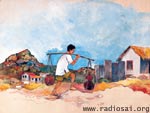 was
remote, withdrawn, and indifferent to worldly matters. If
He spoke, which was rarely, it was always on spiritual matters.
At times He would burst into non-stop recitation of Vedic
hymns He had never learnt. On matters philosophical and spiritual,
He dared even to correct elders, acknowledged experts, and
scholars, something He was never known to do before. was
remote, withdrawn, and indifferent to worldly matters. If
He spoke, which was rarely, it was always on spiritual matters.
At times He would burst into non-stop recitation of Vedic
hymns He had never learnt. On matters philosophical and spiritual,
He dared even to correct elders, acknowledged experts, and
scholars, something He was never known to do before.
Sathya was then taken to other places like Bellary and Dharmavaram
for treatment but there was no improvement. One more attempt
was made and this time He was taken to an exorciser in Kadri,
a mean and cruel person. Here, young Sathya was put through
incredible physical torture, unimaginable even in the proverbial
Hell. The witch-doctor was verily an agent of death, and when
his atrocities mounted, Sathya was whisked away back to home
in Puttaparthi.
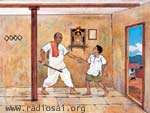 Days
and weeks passed, and Sathya continued to be "abnormal".
Came May 23, 1940, and with it a revelation. That morning
Sathya was in a good mood, materialising flowers and sugar
candy in plenty, and distributing them to all those who called
on Him. Father Venkama Raju heard about this but was neither
pleased nor amused. Suspecting trickery, he armed himself
with a big stick, approached Sathya, and asked, "Who
are You? Are You God, ghost, or Devil?" The big moment
had arrived and Sathya calmly replied, "I am Sai."
The stick slowly slipped out of Venkama Raju's hand but he
still remained puzzled. And so he asked: "What are we
to do with You?" Sathya replied, "Worship Me."
The father's next question was, "When?" Came the
answer: "Every Thursday." That was when the worship
of Sathya Sai first commenced. Days
and weeks passed, and Sathya continued to be "abnormal".
Came May 23, 1940, and with it a revelation. That morning
Sathya was in a good mood, materialising flowers and sugar
candy in plenty, and distributing them to all those who called
on Him. Father Venkama Raju heard about this but was neither
pleased nor amused. Suspecting trickery, he armed himself
with a big stick, approached Sathya, and asked, "Who
are You? Are You God, ghost, or Devil?" The big moment
had arrived and Sathya calmly replied, "I am Sai."
The stick slowly slipped out of Venkama Raju's hand but he
still remained puzzled. And so he asked: "What are we
to do with You?" Sathya replied, "Worship Me."
The father's next question was, "When?" Came the
answer: "Every Thursday." That was when the worship
of Sathya Sai first commenced.
One Thursday, someone challenged: "If
You are Sai Baba, show us some proof." Sathya then asked
for some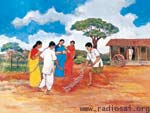 flowers. A bunch of jasmine flowers were given to Him. He
threw them on the floor; instead of falling randomly, they
got neatly arranged to form the words SAI BABA in Telugu.
Such revelations not withstanding, Sathya was forced to return
to Uravakonda and resume school.
flowers. A bunch of jasmine flowers were given to Him. He
threw them on the floor; instead of falling randomly, they
got neatly arranged to form the words SAI BABA in Telugu.
Such revelations not withstanding, Sathya was forced to return
to Uravakonda and resume school.
Looking back, one can see that starting from the very beginning
and particularly from March 1940, Sathya had been gradually
setting the stage for what was soon to follow. Right from
the time He was a little boy, He had, constantly and consistently,
displayed the Divine qualities of compassion, sacrifice, forbearance,
and selfless Love. Occasionally, He performed miracles to
drop hints that He was indeed far beyond the normal. Repeatedly
He demonstrated His ability to absorb enormous cruelty and
physical punishment without any trace of hatred or rancour
towards those ill-treating Him. And last but not the least,
He constantly diverted the attention of one and all from the
mundane to the Divine.
 Came
finally the day to snap all worldly ties and launch the Mission
He had incarnated for. October 20, 1940 was that day. In the
morning of that day, Sathya left for school as usual but within
minutes He was back home. Standing on the doorstep, He flung
aside the bag containing books and in ringing tones declared,
"I am no longer your Sathya. I am Sai. I don't belong
to you. I have My work. My devotees are calling Me. I am going.
I can no longer stay here." Walking up to a neighbour's
house, He sat on a rock in the middle of the garden there
while people flocked, bringing flowers. And then, most lovingly
and compassionately Sri Sathya Sai Baba led the congregation
in a Bhajan that has now become very familiar to us.
He sang: Came
finally the day to snap all worldly ties and launch the Mission
He had incarnated for. October 20, 1940 was that day. In the
morning of that day, Sathya left for school as usual but within
minutes He was back home. Standing on the doorstep, He flung
aside the bag containing books and in ringing tones declared,
"I am no longer your Sathya. I am Sai. I don't belong
to you. I have My work. My devotees are calling Me. I am going.
I can no longer stay here." Walking up to a neighbour's
house, He sat on a rock in the middle of the garden there
while people flocked, bringing flowers. And then, most lovingly
and compassionately Sri Sathya Sai Baba led the congregation
in a Bhajan that has now become very familiar to us.
He sang:
Manasa bhajare Gurucharanam,
Dustara bhavasagara tharanam.
O mind! Meditate on the Lotus Feet of the Lord!
That alone will help you to sail across the turbulent sea
called life.
The Avatar had finally revealed Himself.
Physically, Sai was still a fourteen-year old. Yet, such was
His magnetism, and such was the faith of the devotees who
flocked to Him that they had no reservation in accepting Him
as a Divine Incarnation.
Baba now decided to return to Puttaparthi
and make it the base for His Mission. The residents of Uravakonda
gave Him a ceremonial and tearful send-off, and Baba was carried
in procession. En route, He was joyfully welcomed and
worshipped in all the villages that He passed through. Back
in Puttaparthi He stayed with His parents for a few days and
then shifted to the house of a pious lady named Subbamma,
who always had abiding faith in the Divinity of Sathya Sai.
Soon, Subbamma's unostentatious abode became a pilgrim centre.
They came in large numbers to worship Sai, and patiently and
tirelessly, Subbamma played hostess to them all. The crowds
kept growing bigger and bigger and a new residence had to
be found for Sai. In 1944, Baba moved to a thatched hut in
a vacant plot of land nearby. The plot was gifted to Swami
by Subbamma. Later the hut was replaced by a tin shed with
verandas on either side - this is the famous Paatha Mandiram
(old Mandir) of Puttaparthi folklore. Baba stayed in the shed
while devotees occupied the veranda. There was a total absence
of creature comforts and indeed even elementary conveniences
that one takes for granted. Yet, for those 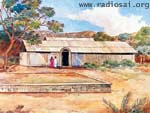 devotees,
sharing the same roof with Bhagavan Baba, was veritable heaven. devotees,
sharing the same roof with Bhagavan Baba, was veritable heaven.
History repeated and Paatha Mandiram
also began to overflow - Baba clearly needed a much bigger
place to receive His devotees. Plans were made and in 1950,
and what is now known as the Mandir (in Prasantinilayam),
came into existence, in bare-bones form of course. Once Baba
moved to Prasantinilayam, the tin shed previously occupied
by Him was replaced by a brick and mortar structure - the
Paatha Mandiram of yore had now become the Pedda Venkama
Raju Kalyana Mandapam (marriage hall); to this day, marriages
are celebrated in this hall.
Every Avatar has a Mission. In 1958,
Bhagavan Sri Sathya Sai Baba revealed that His Mission would
unfold itself in stages. The first sixteen years would be
dominated by contact with individuals. Following this, attention
would be given to groups. In the next phase, spiritual exhortation
would be the dominant feature, after which service to humanity
at large would become the principal focus.
Baba moves, lives, and acts like ordinary
mortals do but His extra-ordinary Love (Prema), if
noticed, would immediately reveal that He is nothing short
of Divinity personified. At times, He uses miracles to draw
attention to His Divine nature, which is why He refers to
His miracles as His visiting card. On occasions, He has explicitly
discussed the nature of the Sai Avatar.
Let us move on to the next section where you can get a glimpse
of the nature of Avatars, in Swami's own words!
|